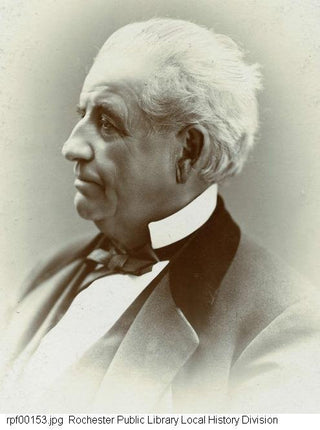Written by Sara Rising

How did one Rochester man kill off the Pony Express?
Imagine you live in California during the Gold Rush. After years of toiling and mining, you finally strike it rich! You immediately want to tell your family and friends back home of your success - especially that one cousin who never thought you’d ‘make it’ out west. Imagine having to wait 2 months for a man on a horse to deliver the great news to your hometown, especially to that one cousin who was totally wrong. No phone calls, no group texts, just a man on a pony.

[Photo Credit: Wikipedia]
However, thanks to Rochester industrialist, philanthropist and pioneer of the telegraph, Hiram Sibley, we no longer have to wait an incredible amount of time to humble brag about our accomplishments!
Hiram Sibley, founder and president of the Western Union Telegraph Company, began his career right here in Rochester. After moving to the area in 1838, Sibley connected with Samuel F.B. Morse (co-developer of the Morse code) and helped get congressional backing for the construction of the first telegraph line. In 1851, he organized the New York and Mississippi Valley Telegraph Company. Believing that many small companies could never be successful, Sibley, along with partners Don Alonzo Watson of Rochester and Ezra Cornell of Ithaca, formed the Western Union Telegraph Company in 1856.
A few years later, in 1860, Congress passed the Pacific Telegraph Act authorizing the government to open bids for the construction of a telegraph line between Missouri and California. Sibley won the bid and helped form the Pacific Telegraph Company of Nebraska. While lines were being built west from Omaha, Nebraska, the Overland Telegraph Company of California was consequently formed and built east from Carson City, Nevada. With their connection in Salt Lake City, Utah on October 24, 1861, the final link between the east and west coasts of the United States of America was made by telegraph. The First Transcontinental Telegraph led to the immediate demise of the Pony Express. The Pacific Telegraph Company and Overland Telegraph Company of California were eventually absorbed into the Western Union Telegraph Company – and a culture of (over)sharing slowly began.
For forty years Sibley was active in Rochester civic affairs and philanthropic endeavors. In 1843, he was elected to a term as County Sheriff and in 1874 he built Sibley Hall for the University of Rochester. In 1876, he founded and endowed the Sibley College of Mechanical Arts at his business partner’s new University, Cornell.
Vestiges of Sibley’s wealth and success can be seen in the grandeur of his 1868 Rochester homestead – the Sibley Mansion, located today at 400 East Avenue. The house was originally constructed in the Italianate style, with a cupola and bracketed details, and sat on a spacious, mulit-acre lot framing East & University Avenues and Prince & Alexander Streets. In 1900, Sibley's grandson remodeled the house in the Georgian Revival-style. The bracketed porch, cupolas and heavy cornices were removed, windows reduced in size and small panes installed. Ionic pilasters and the brick facade were applied. The mansion was a Sibley family residence until 1974. Georgiana Sibley, a community activist for civil rights, public housing, and world peace, moved out of the family home to live with her daughter, Jane Auchincloss , in Millbrook, New York . A four day estate sale was held that year and was attended by over 2,000 people looking for souvenirs of the Sibley era. Afterwards, no family owned furnishing or lighting was left!
Currently, the Sibley Mansion is home to PathStone, a not-for-profit community development and human service organization that provides services to low-income families and economically depressed communities throughout New York, Pennsylvania, New Jersey, Ohio, Indiana, Virginia, Vermont, and Puerto Rico. PathStone builds family and individual self-sufficiency by strengthening farmworker, rural and urban communities and promoting social justice through programs and advocacy – a mission that keeps with the philanthropic ideals of the home’s original residents. The homestead was listed on the National Register of Historic Places in 1985 and is also included in the East Avenue Historic District.
So, thank you, Hiram Sibley, for advancing instant communication and giving many lucky individuals a beautiful place to give back to the community. (Note: The author happens to be one of those lucky individuals!)
References:
Hiram Sibley Family Papers, University of Rochester: River Campus Libraries
Wikipedia
Encyclopædia Britannica
RocWiki
PathStone


